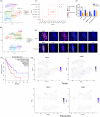Single-cell transcriptomic analysis deciphers key transitional signatures associated with oncogenic evolution in human intramucosal oesophageal squamous cell carcinoma
- PMID: 36855810
- PMCID: PMC9975454
- DOI: 10.1002/ctm2.1203
Single-cell transcriptomic analysis deciphers key transitional signatures associated with oncogenic evolution in human intramucosal oesophageal squamous cell carcinoma
Abstract
Background and aims: The early diagnosis and intervention of oesophageal squamous cell carcinoma (ESCC) are particularly important because of the lack of effective therapies and poor prognosis. Comprehensive research on early ESCC at the single-cell level is rare due to the need for fresh and high-quality specimens obtained from ESD. This study aims to systematically describe the cellular atlas of human intramucosal ESCC.
Methods: Five paired samples of intramucosal ESCC, para-ESCC oesophageal tissues from endoscopically resected specimens and peripheral blood mononuclear cells were adopted for scRNA-seq analysis. Computational pipeline scMetabolism was applied to quantify the metabolic diversity of single cells.
Results: A total of 164 715 cells were profiled. Epithelial cells exhibited high intra-tumoural heterogeneity and two evolutionary trajectories during ESCC tumorigenesis initiated from proliferative cells, and then through an intermediate state, to two different terminal states of normally differentiated epithelial cells or malignant cells, respectively. The abundance of CD8+ TEX s, Tregs and PD1+ CD4+ T cells suggested an exhausted and suppressive immune microenvironment. Several genes in immune cells, such as CXCL13, CXCR5 and PADI4, were identified as new biomarkers for poor prognosis. A new subcluster of malignant cells associated with metastasis and angiogenesis that appeared at an early stage compared with progressive ESCC was also identified in this study. Intercellular interaction analysis based on ligand-receptor pairs revealed the subcluster of malignant cells interacting with CAFs via the MDK-NCL pathway, which was verified by cell proliferation assay and IHC. This indicates that the interaction may be an important hallmark in the early change of tumour microenvironment and serves as a sign of CAF activation to stimulate downstream pathways for facilitating tumour invasion.
Conclusion: This study demonstrates the changes of cell subsets and transcriptional levels in human intramucosal ESCC, which may provide unique insights into the development of novel biomarkers and potential intervention strategies.
Keywords: intramucosal; oesophageal squamous cell carcinoma; single-cell RNA-seq; tumour microenvironment.
© 2023 The Authors. Clinical and Translational Medicine published by John Wiley & Sons Australia, Ltd on behalf of Shanghai Institute of Clinical Bioinformatics.
Conflict of interest statement
The authors declare no conflict of interest.
Figures








References
-
- Sung H, Ferlay J, Siegel RL, et al. Global Cancer Statistics 2020: gLOBOCAN estimates of incidence and mortality worldwide for 36 cancers in 185 countries. CA Cancer J Clin. 2021;71(3):209‐249. - PubMed
-
- Zhang Y, Ding H, Chen T, et al. Outcomes of endoscopic submucosal dissection vs esophagectomy for T1 esophageal squamous cell carcinoma in a real‐world cohort. Clin Gastroenterol Hepatol. 2019;17(1):73‐81.e3. - PubMed
-
- Oppedijk V, van der Gaast A, van Lanschot JJ, et al. Patterns of recurrence after surgery alone versus preoperative chemoradiotherapy and surgery in the CROSS trials. J Clin Oncol. 2014;32(5):385‐391. - PubMed
Publication types
MeSH terms
Grants and funding
- 2019CXJQ02/Shanghai Municipal Health Commission Collaborative Innovation Cluster Project
- 82003074/National Natural Science Foundation of China
- 82172787/National Natural Science Foundation of China
- 18CG07/Chen Guang Program of Shanghai Municipal Education Committee
- SHWJRS(2021)-99/Shanghai 'Rising Stars of Medical Talent' Youth Development Program
LinkOut - more resources
Full Text Sources
Medical
Research Materials
Miscellaneous
